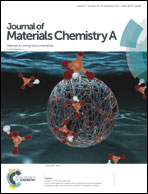Enhancing the thermoelectric performance of Cu3SnS4-based solid solutions through coordination of the Seebeck coefficient and carrier concentration†
Abstract
Improving the thermoelectric (TE) performance of Cu3SnS4 is challenging because it exhibits a metallic behavior, therefore, a strategy should be envisaged to coordinate the carrier concentration (nH) and Seebeck coefficient (α). The coordination in this work has been realized through the Fermi level (Ef) unpinning and shifting towards the conduction band (CB) via addition of excess Sn in Cu3SnS4. As a result, the solid solution Cu3Sn1+xS4 (x = 0.2) has a moderate α (178.0 μV K−1) at 790 K and a high nH (1.54 × 1021 cm−3) value. Along with the lowest lattice thermal conductivity κL (0.39 W K−1 m−1) caused by the increased phonon scattering by carriers, the highest ZT value of 0.75 is attained at ∼790 K. This value is 2.8 times that of the stoichiometric Cu3SnS4, and stands among the highest for ternary Cu–Sn–S sulfide thermoelectrics at the corresponding temperatures. More importantly, this approach used in the case of ternary Cu3SnS4 provides a guidance or reference to improve the TE performance of other materials.



 Please wait while we load your content...
Please wait while we load your content...